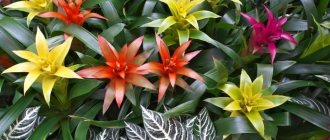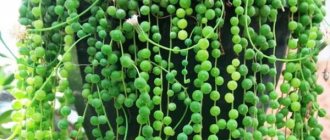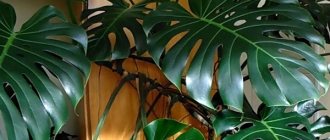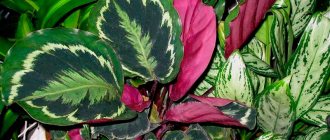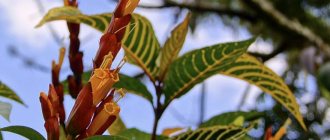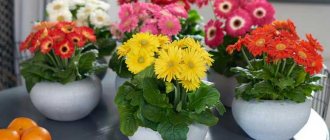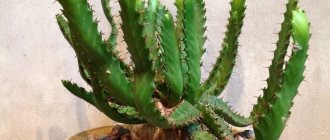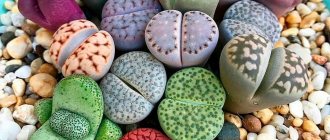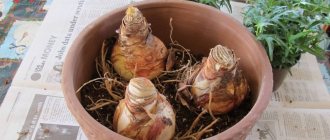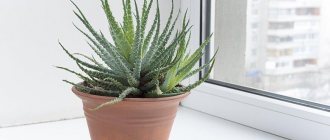Guzmania flower. Photo
A popular plant in the world of indoor flowers, it belongs to the Bromeliad family (monocots from the order Pormaceae). In its natural environment it grows in tropical thickets of South and Central America, Brazil, and some regions of West Africa.
Under its usual conditions, this evergreen plant, reaching a height of 75 centimeters, grows as an epiphyte, placing and developing its root system on the bark or branches of dying trees, and not on the ground. The plant obtains water through aerial roots from air saturated with moisture.
general characteristics
When you see Guzmania for the first time, it is completely impossible to guess that the plant is an epiphyte and grows in natural conditions on the bark of old tropical trees.
Brief botanical description
- It is native to the southern part and center of America. Located on tree trunks, the plant receives the required amount of moisture from the air. Therefore, it is necessary to maintain the desired level of humidity in the room.
- There are about 100 species of Guzmania in the world, but only a few are often grown indoors: Reed and Minor Rondo.
- Many people consider the flower to be very capricious and whimsical. But this opinion is not entirely true. If all agrotechnical rules are followed, guzmania can be successfully grown and propagated.
- The most vulnerable is the root part of the plant. After flowering, the flower dies, so you need to quickly replant it.
- In the wild, the height of the bush reaches 70 - 80 cm. In a room, guzmania usually does not grow more than 40 cm. It does not have enough light, humidity, and the root system does not have enough space to develop in a pot.
- The plant is most decorative when it blooms: against the background of lush green foliage we can see red, dark pink, burgundy flowing petals.
Interesting: guzmania is good to grow indoors, since its great advantage is its ability to absorb dust and purify the air.
Transplant after acquisition
As soon as the plant appears in the house, it must be placed in a new pot as quickly as possible and given a new place of residence.
Soil composition
Not every soil can be used for the process of replanting guzmania. The substrate must conduct moisture and air very well, be light and loose. We can recommend the following composition:
- 1 part turf;
- 1 part sand;
- a pinch of charcoal;
- 1 part peat in the form of fibers.
There is this option:
- 1 share of Sphagnum moss;
- 3 shares of coniferous tree bark (fern roots can be used);
If you don’t yet have experience in growing such plants, then purchase a ready-made substrate for orchids or bromeliads. It is also suitable for growing Guzmania.
Choosing a pot and planting
You should not purchase a flowerpot that is too deep, as caring for the root system will be difficult. Choose a shallow pot, with a diameter of no more than 10 - 12 cm.
Please note that the drainage layer fills at least two-thirds of the container. When replanting, experienced flower growers recommend using the transshipment method. The root system is very delicate and fragile, so it must be handled very carefully.
Indoor Guzmania flowers
Home conditions differ from natural conditions, which provide the flower with a comfortable existence. Growing under the dense foliage of tall trees, it receives enough diffused light, since in the tropics the sunlight is much brighter. There is also enough moisture, it hovers in the air and aerial roots feed on it.
In indoor conditions, guzmania is grown as an annual herbaceous plant, its height reaches 45 centimeters, but it is still affected by the lack of moisture, air, and light. But the flowers sold in stores are to some extent adapted to indoor conditions, which are quite accessible, although not always easy, to create.
Let's get to know each other better
A herbaceous evergreen epiphyte (from the Greek “phytón” - “plant”) loves to settle on old branches and in crevices of tree bark, in internodes and in hollows. However, this is by no means a parasitic plant, as it might seem; the Epiphylla genus is too proud and independent to feed on the juices of the owner who provided it with “living space”.
In this, guzmania is similar to an orchid, which also receives everything it needs from the environment without depriving the plant that shelters it of vitality.
Interesting fact. Having underdeveloped roots and not rooting tightly into the ground, the flower can move itself in one direction or another, to where it is more comfortable. True, the length of the crossing will be some 2-3 cm.
Guzmania, which has more than 100 species, manages quite well without “warm housing”, sprouting right along the mountain slope, taking root among mosses, ferns and lichens.
The main conditions: warmth, moisture and diffused light. Everything is like in the tropics of Central America, Brazil, the West Indies, southern Florida and Venezuela, whose jungle forests are the plant’s homeland.
The correct name of the flower is GuSmania, since the epiphyte received its name as a gift from the botanist, treasure hunter and zoologist, Spanish naturalist Anastasio Guzman, who was the first to describe this interesting plant with an unusual inflorescence that resembles a cone and a panicle at the same time.
Moreover, he did this along the way while he was looking for Incan gold in the Llanhanates Mountains (Ecuador), and went down in history not as a treasure hunter, but as a botanist who discovered a new species in 1802.
Types of Guzmania
GuZmania has taken root in the Russian version, but this does not in any way affect the popularity of the indoor plant, especially since every gardener can choose a flower according to color and even to taste.
Domestic cats who like to taste green spaces can calmly chew the lance-shaped leaves: guzmania juice is bitter, but not poisonous.
The most common types found in homes are:
- reed (GuzmanialingulataMez);
- Donnell-Smith (Guzmaniadonnell-smithii);
- single-spike (Guzmania monostachia mez);
- Nicaraguan (GuzmanianicaraguensisMez);
- blood red (Guzmaniasanguinea);
- mosaic (Guzmaniamusaica).
Less commonly seen:
- Tsana (Guzmaniazahnii) is the largest of the domestic Guzmania species;
- Minor Rondo is a small hybrid temptation up to 20 cm tall;
- Tempo - on a light green background of leaves there is a bright scarlet panicle-bract.
Sometimes lovers of indoor beauty are offered to purchase a “new” variety of Guzmania - Guzmania Mix. This type does not exist! This is a mixture of flower varieties having red, white, yellow and orange bracts, grown in the same container.
This mix mixture looks very decorative (it all depends on the collected species and the length and color of the bracts), blooms for a long time - from March to September (again, depends on the collected species).
But at the end of flowering, the mix should be planted in different pots: after flowering, the mother head dies, giving life to new basal shoots.
Guzmania blooms only once in its entire life, but the duration of flowering in some species reaches up to 20 weeks!
How to care for guzmania. Video:
Guzmania (Guzmania, Gutzmania). How to Care for Guzmania. Beautiful Bromeliads
Guzmania at home care
Being in the natural conditions of rainy South American forests, the plant survives in rather harsh conditions:
- the root system is underdeveloped, poorly adapted to fully supply the flower with moisture and nutrition;
- despite the abundance of sun, the plant is shaded by tall trees;
- it is content with moisture that accumulates in the rosette after rains and which is supplied by aerial roots.
However, these are exactly the conditions that suit the flower best. Is it possible to create conditions close to natural conditions in a home environment? Of course, because real flower growers are obsessed people, ready to do anything for their pets.
The most suitable location
Ideal for a slightly capricious bromeliad, placing it in the back of a bright room would be an aquarium or terrarium with wet sand at the bottom. This is the easiest way to create the conditions of heat and humidity necessary for the flower. But if there are many copies, such maintenance of guzmania will be very expensive and burdensome.
Therefore, you need to place the flower in a bright, warm room without drafts, but with the possibility of ventilation to provide it with access to fresh air. You can choose a place near the eastern or western window, but it is better to place the flowerpot not on the windowsill, but on a special stand.
Required temperature
It is not difficult to create a comfortable temperature for a flower to grow and bloom. The plant is tropical, but it is not demanding on high readings on the thermometer.
During the spring-summer period, it is enough to provide 23 - 250 C; this regime is especially important during the flowering period, so that the bracts delight the eyes of the owners with their beauty for as long as possible.
Guzmania can withstand higher thermometer readings, but not for a long time, because the dry air in the room will definitely cause the edges of the leaves to dry out.
High temperatures should be compensated by high air humidity (60 - 80%). In winter, during a period of relative rest, the best temperature is 18 – 200 ºС. The most important thing is not to allow the temperature to drop below 160 ºС so that the plant does not become hypothermic.
How to properly water an exotic plant
The method of watering the bromeliad family differs from the traditional, usual moistening of the soil in a pot. Water must be poured from above, onto the outlet, in a small amount. The water collected in the pan must be drained.
Only use water that has been standing for at least two days, soft and warm. This matters because hard water leaves a coating on the leaves. If possible, it is best to use warm rainwater.
The flower does not like to be watered often; it is easier for it to tolerate dried soil than water that has stagnated in a socket or tray. Unless on hot, dry days you can fill the tray a little with water.
In summer it is necessary to water frequently, daily in small quantities or every other day. In winter, one or two waterings per week are enough. Spraying with room water from a spray bottle is required daily.
Guzmania likes to wipe the foliage with a damp sponge, thus removing dust from the leaves, as well as possible pests. The most vulnerable part of the guzmania is the root system; the roots can quickly rot if not watered correctly.
It is important to know! In the summer months, when the weather is hot, you need to try to keep the central funnel formed by the leaf rosette constantly filled with water; every 20 to 30 days, the water in the rosette needs to be replaced with fresh water.
Fertilizers for Guzmania
The plant especially does not need feeding, because in natural conditions it grows not on the ground, but on the bark of trees, and receives scanty nutrition. For houseplants, fertilizing is done mainly to stimulate flowering and prolong it.
You can use fertilizers for bromeliads or universal fertilizers for flowering indoor plants (“Rossa”, “Bud”, “Agricola”, “Ovary”). Overfeeding should be avoided; the concentration of the fertilizer solution should be prepared weaker than indicated according to the instructions.
Fertilizer is poured into the outlet in the same way as water when watering, excess fertilizer solution is drained from the tray, and wiped off the leaves with a sponge or soft cloth. If flowering occurs without deviations over several months, you can do without fertilizers.
Are you familiar with the houseplant anthurium, which is called “male happiness”? Read the article: Anthurium care at home.
Required lighting level
Guzmania is photophilous, but does not tolerate direct rays of bright sun, so it is better not to place it on a southern windowsill. Or, as a last resort, curtain the window to protect the flower from burns. The best windows for placement will be those oriented to the west and east.
Prolonged shading should also be avoided, otherwise the bracts will lose their charm over time, gradually losing the brightness of their color, and in the future they will simply become green.
For months with short days and long nights, it is necessary to provide additional illumination with a special phyto-lamp, since even in winter the plant needs long days and sufficient lighting.
Air humidity requirements
A guest from the humid tropics, guzmania does not tolerate dry microclimates; it needs to be provided with humidity. This is easy to do by regularly spraying the flower and thus creating moisture around it.
It is important to know! When spraying, you need to make sure that the sensitive leaves are not exposed to direct sun, otherwise burns cannot be avoided.
In the spring and summer months, it is advisable to carry out moisturizing procedures two to three times a day. During the winter months, if there are no heating devices near the flower, several sprays per week will be sufficient. If the flower is located close to the heating system, it will have to be moistened daily.
In winter, you can humidify the air in the room where guzmania grows by hanging wet towels on the radiators. In summer, pour sand into trays, moisten it, and place a flowerpot with a flower on the wet sand.
What substrate is needed
An extraordinary plant also needs unusual soil. The usual soil will not work here; a different composition is required:
- fibrous peat;
- sphagnum;
- turf land;
- pieces of coniferous tree bark;
- coarse sand.
The components are taken in equal doses and mixed.
If some component cannot be purchased, ready-made soil “for bromeliads” or for orchids is purchased for the plant.
It is important to know! When working with a plant, it can release juice, which is not poisonous, but causes irritation to the skin or mucous membranes if it gets on them.
Transfer
After the plant appears in the house, caring for it begins with replanting; store-bought soil is only suitable for transportation. The soil is prepared, you need to choose a suitable flowerpot, low and wide: the root system of bromeliads is superficial, a deep pot is not needed. A small layer of drainage and a thin layer of coal are placed at the bottom, preventing the development of putrefactive processes in the soil.
After the drainage and coal layers are prepared, the earth is poured into a mound, the plant is placed on it, and the roots are straightened out very carefully (they are quite fragile in guzmania, they must be handled with extreme care). Next, add soil to the level of the flower’s neck and knock the bottom of the flowerpot several times on the surface of a table or window sill. The earth will thus be compacted and more can be added. The neck cannot be deepened.
You should not compact the soil by hand for several reasons:
- the soil should remain light, loose, with air access to the roots;
- less chance of injuring the root system.
The transplanted plant is placed in a place where it is warm and light, but there are no drafts.
It is important to know! Transplantation is necessary only under two conditions: after purchasing a flower in a store and during propagation.
The transplanted bromeliad needs to be watered: both the soil and the flower itself.
Feeding
After flowering, guzmania continues to be cared for as before : having lost its decorative effect, the plant is able to form root shoots.
To stimulate this process, a special organic-mineral fertilizer “for Bromeliads” is used.
Also used are fertilizers “for orchids” or universal ones intended for flowering indoor crops. However, in this case, the concentration indicated in the instructions should be reduced by 3-4 times.
Do not moisten the substrate near the base of the rosette with fertilizing , as you can damage (burn) the roots. It is better to use a fertilizer solution to spray on the leaves. In addition, the dosage and frequency of fertilizer application should be observed. Feeding is carried out no more than twice a month with an interval of 14-15 days.
Reproduction
In the home environment, evergreen bromeliad grows for one year, rarely for two. After a period of prolonged flowering, the plant begins to die. Some beginners in breeding guzmanias, not knowing this feature of the flower, get very upset. But this is the natural course of events.
The faded plant dies, and small sprouts, children, begin to replace it from the mother flower.
It is important to know! Guzmania babies are formed during its flowering.
When the young shoots reach approximately 15 centimeters and produce their fourth leaf, by this time they have sufficiently developed their own root system, they are ready to be transplanted into their own pots.
The flower is removed from the flowerpot, the shoots and roots are cut off from the mother bush with a sharp knife, and the old plant is destroyed. If the roots are preserved and properly cared for, young plants quickly begin to grow, and after three years they should begin to bloom.
In order for the young shoots to develop faster, and for them to flower within a year, it will be necessary to create additional conditions during cultivation: place them in an aquarium or create a primitive greenhouse from a plastic bag. This achieves higher humidity and temperature (26 - 28 degrees). Watch the video on how to separate Guzmania babies from the mother plant.
Some gardeners act differently: they do not plant the children, leave them in place, and after they get stronger, cut off the mother plant.
It is important to know! You can not rush to throw away the mother bush, but move it to a shaded place where a new batch of children will be stimulated; they are left in the same flowerpot, carefully trimming the mother bush.
How to propagate
Reproduction during transplantation is carried out frequently. The babies are transplanted when the length of their roots is about 1.5 cm. The baby is cut with a tool; it must be sharp and sterilized in advance. The cut areas are coated with varnish.
The lateral roots of the processes are formed in different ways: at one speed or another. It is not always possible to transplant them at once. The children are transferred to separate pots filled with a soil mixture specifically for orchids. After this, the flowerpots are transferred to a warm place without drafts.
Beautiful pots with Guzmania flowers
Another method of propagation is by seeds. The substrate for bromeliads with crushed peat and sand is poured into the container. The seeds should be washed in a solution of potassium permanganate, dried and scattered evenly on the ground. There is no need to make any deepening; it is necessary to cover the container with glass or film. The picking is done when the seedlings are 8 to 10 weeks old. Any soil mix with peat, turf, or leaf soil will do. After another 15 days, the bushes can be transferred to permanent pots.
For your information! Flowering is expected no earlier than in three years.
Types and varieties of Guzmania
There is a wide variety of varieties in the world of guzmanias, which open up opportunities for lovers of these flowers to admire their unusual beauty all year round by choosing the right varieties with different flowering periods. This also makes it possible to choose specimens with different leaf colors - from bright green to striped and spotted.
The length of the leaves of a flower is determined by its type and ranges from 30 to 60 centimeters. The main decoration of a flower, for which it is so loved, is the bract, the shape and color of which varies and is determined by the variety. The bracts come in different shades of yellow, pink, brown, red, even white.
Tempo. The leaves of this flower variety are light green with a golden tint. The leaves are long, form a large rosette and have a bright, red bract.
G.Tempo
Mix. There is no separate variety under this name; in flower shops this word refers to the generally accepted definition of the various colors that are inherent in the bracts of guzmanias.
g.mix
Minor. One of the most common varieties, also called guzmania reed - has green shiny wide-linear (up to 4 centimeters) leaves and very bright bracts. Has a long flowering period.
g.minor
Other varieties of exotic flowers:
- Lemon guzmania, distinguished by its bright yellow bracts.
- Mosaic guzmania - leaves up to 70 centimeters long with brown stripes, spreading rosette, straight peduncle.
- Guzmania Donnell-Smith - yellow bracts, green leaves with pale scales.
An exotic plant with its bright peduncle can decorate any room, becoming an exquisite element of the interior.
guzmania reed
Features of different types (briefly)
Most species are difficult to classify for novice florists, since all guzmanias have a flat root rosette, assembled according to the principle of a cabbage head with a funnel-bowl (for storing moisture and food) and long, narrow leaves that droop from the bottom (old) and open upward with fountain jets ( young).
The length of the leaf, depending on the species, varies from 35-40 cm to 70. The diameter of the wide mother head rarely exceeds 30 cm.
The small, bright plume, reminiscent of the top of a pineapple (with which Guzmania is directly related), is mistaken by novice “Guzmania” growers for its flower. But the real flowers are so small that you have to peer into the middle of the bright leaves to notice them.
What is mistaken for flowers is a bright plume, a modified bract (stipule or bract) created by the plant to attract pollinators.
Bract - young, glossy, shortened upper leaves that appear before the peduncle is thrown out, often round, taking on contrasting colors and creating the illusion of a multi-leaf flower cup.
GuzmanialingulataMez – reed
The head of cabbage is assembled from 20-30 rosette leaves 3-4 cm wide and up to 45 cm long - smooth, whole, pointed at the end.
The peduncle is dense, thick, straight, shorter than the leaves.
The bract is 10-15 cm, wraps around the flower like a cap.
The inflorescence itself is simple, corymbose, 5-7 cm in diameter. It has many small flowers fused together. Fused with the petals and stamens of flowers.
Color range: pink, red, burgundy, white, yellow, cream, pale green and orange.
Guzmania reed is often kept in the house in several varieties in order to admire the unusual inflorescences throughout the year:
- Cardinalis (Cardinal) – blooms in March-August and July-December;
- Minor (Minor) – February-July;
- Flammea (Flamia) – May-November.
There are also reed Cherry, Lingulata, Corn, Denise, etc. All are in demand due to the variety of colors of the stipules.
A hybrid version of the indoor reed guzmania - Minor Rondo - is often called simply Minor for its small height (20 cm), and is loved for the extraordinary brightness of its various plumes against the background of rich green narrow rosette leaves.
Guzmaniadonnell-smithii - Donnell-Smith
One of the first epiphytes to migrate to Europe.
The head is loose, the rosette is loose. Green and tongue-shaped leaves, up to 60 cm long, are pointed at the ends, as befits all guzmanias.
Stipules are orange or bright yellow.
Peduncle straight, short. The inflorescence itself is complex and large.
The inflorescence is 10-15 cm long, with a spikelet-panicle on a bare axis.
The spikelet consists of many tightly compressed flowers, 1-1.5 cm long, in bright colors: deep pink, deep crimson, lilac-yellow, light green-white, white with scarlet, red-brown with orange. Blooms from April to May.
Guzmania monostachiaMez – single-spike
The juicy yellow-green leaves of this epiphyte are coquettishly colored here and there with white speckles.
The wide leaf below may die and be shed, which is not a sign of disease.
Bottom leaf – up to 40 cm long; top – 5-7 cm.
The head of cabbage is dense; an elongated, straight, multi-row ear emerges from the very center, pointed towards the top. The length of the peduncle is up to 15 cm.
If the flower is sterile, it blooms bright red or snowy white.
In flowers that form a seed pod, the flowers are much paler, and the petals have a brown vein running through them, like a thin line.
Often the stipules of sterile plants have a deep brown-red color.
There are “single-grass plants” with a wide leaf and yellow longitudinal stripes. These have a darker top leaf, while the lower, rosette leaves, on the contrary, have a lighter tone.
Two types of single-spike Guzmania are especially beautiful:
- Variegata - with beautiful bright leaves, randomly shaded with white strokes and speckled spots;
- Alba - with rosette leaves of rich green color, and the upper leaves are pale light green or pure white.
Often Guzmania unispica with a light top is called Alba, without even realizing that it is a species of tropical flower of the Bromeliad family.
GuzmanianicaraguensisMez – Nicaraguan
Despite the name, this epiphyte thrives in Europe and Asia with proper care, of course.
Short, wide leaves (L 6-8 cm; H 2.5-3 cm), numbering at least 10-12, form a dense funnel-shaped head, “shooting” a single peduncle with a simple few-flowered spike of 10 cm.
The spike is planted with flowers on short stalks, the petals fused into a narrow tube, with the edges turned outward. Flower size – 2 cm.
Yellow spikelet flowers bloom from March to April.
Guzmaniasanguinea – blood red
Until the flower is about to bloom, it does not attract much attention to itself.
Rosette – 30 cm; leaves are ordinary, long, pointed, up to 40-45 cm long. The plant itself is small - 20-25 cm in height - and would look like a small baby Guzmania, if not for the leaves, which are huge for such a baby.
It's something completely different when Guzmania gets ready to bloom! The inside of the head of cabbage is painted bright red, and the upper leaves also acquire the same color.
5-7 days after the color change, scarlet corymbose inflorescences appear, consisting of 7 (sometimes up to 15) flowers, each 6-8 cm long! The inflorescences sit on such a short stalk that they seem to grow straight from the rosette.
Some varieties have cream or greenish-white flowers, which look unusually impressive against a blood-red field of short, wide leaves!
Rolling pollen covers the juicy red plates with a yellowish “powder”, which gives the blooming flower an additional spectacular decorative effect.
Guzmaniamusaica – mosaic
A spreading rosette of loose cabbage is formed by long 70-centimeter leaves, reaching a width of 8 cm at the base.
The upper ones are young, erect with a rounded tip. As the leaves grow, they descend downward, taking on the pointed, elongated shape characteristic of the plant.
The flower itself resembles a fountain, in the center of which in July or August a capitate orange inflorescence of 20-25 flowers grows, surrounded by pink stipules.
The flowering period is short - 35-40 days. The main decorative load is carried by green leaves, completely covered with a varied mosaic of white and cream lines in a random design.
Flower growers are happy to breed mosaic epiphyte hybrids in their homes:
- Concolor;
- Musaika;
- Zebrina.
Guzmaniazahnii – Tsana or Zana
The Colombian beauty throws out leaves 70-90 cm long! The shade of the rosette leaf can be reddish or yellowish - it all depends on the color of the veins.
The Variegated species also has white longitudinal stripes.
Before flowering, in the center of a wide rosette, a real plume of bract leaves up to 70 cm high rises, which by that time acquire a bright yellow or golden-ocher color.
The spike consists of many pale golden flowers, collected in tight inflorescences at the top of the peduncle.
Only Guzmania Hilda dares to compete with the beauty and article of Zana, since it throws out its lemon-yellow bracts to a height no less than Zana - 65 cm. And the flower will remain like this for 115 days!
Guzmania beautiful flower
Common growing problems
Usually, if all requirements are met, difficulties with cultivation should not arise. If any conditions of detention are not met, the bromeliad gives a signal.
Growth has stopped. What is the problem? It happens that for a number of years a plant is kept in one flowerpot and does not have enough nutrition. This applies to adult guzmanias. Regarding the “babies”, there can be a lot of them in one flowerpot, they also lack nutrients. The second reason is that the bromeliad has grown and is preparing to bloom.
The leaves are withering . The reasons may be improper (excessive) watering, stagnation of water in the outlet, or excess bright light. The leaves begin to wither when pests settle on the plant.
The bract has faded, but new shoots do not appear. You need to cut off the flower stalk. Seeds ripening at this time can greatly inhibit the emergence of young shoots.
Pests and flower diseases, their elimination
We can say that guzmania is not a painful plant, it is also rarely affected by pests, the main cause of damage is improper care.
The fact that the flower has been attacked by pests (most often spider mites, root bugs, scale insects) will be indicated by spots that appear on the leaves and stem. The spots are predominantly black, yellow, and brown.
If such spots appear, wipe the leaves with a sponge soaked in soapy water. If the pest infestation is numerous, you will have to use insecticides.
Preventive spraying with water helps protect the flower from spider mites and other parasites.
Dry indoor air is a common cause of disease, causing leaves to turn brown and fall off. It is necessary to carry out regular irrigation with warm, settled water.
The other extreme is too much moisture. Then fungal diseases develop, which are indicated by gray spots appearing on the lower leaves. Humidity urgently needs to be reduced and the plant treated two or three times with a fungicide.
Guzmania flower does not bloom, what to do
You already have to wait from three to five years for this exciting moment, but even after such a long wait, flowering does not occur. There may be several reasons for this:
- lack of light, or, conversely, too bright light;
- lack of moisture, dry air;
- need for feeding.
It is necessary to determine which of the conditions is violated in order to correct the situation. In a month or a month and a half, the flower should begin to bloom.
It is important to know! Some experienced flower growers use a simple, cunning method to speed up the process of flowering: place a slice of apple or a slice of banana in a flowerpot next to the plant, cover the flower with a bag on top, and periodically replace the fruit with fresh ones. Thus, the gas released from the fruit stimulates the onset of flowering.
As you can see, it is possible to adapt to growing such an unusual and beautiful guzmania at home; it is not too demanding in terms of care. But she knows how to thank her owners for quality care - the long-term flowering of her luxurious flower stalks.
PS Have you ever thought about how much dust is in the air in your apartment when you use a regular vacuum cleaner? Personally, I use the Nord vacuum cleaner and am not at all satisfied with its performance! I looked into the online store and was happy to learn a lot of interesting things about aqua vacuum cleaners. I think that soon there will be no dirt or bacteria in my house!
